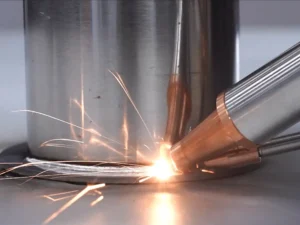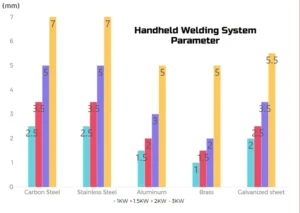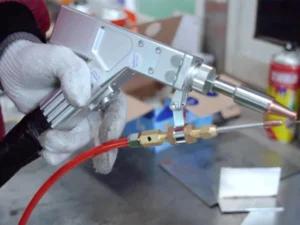Introduction:
Laser welding is a process that utilizes a highly focused beam of light energy, known as a laser, to join materials together. So, how does laser welding work? This article will give you the answer.
How does laser welding work?

1. Generation of Laser Beam
The process starts with generating a highly concentrated beam of coherent light, usually from a laser resonator. The laser beam can be produced using different lasers, such as solid-state, gas, or fiber lasers.
2. Focusing the Laser Beam
Once generated, the laser beam is directed through a series of mirrors and lenses to focus it into a small, intense spot. This focus is crucial. It increases the energy density of the laser beam, allowing it to melt or vaporize the material it interacts with.
3. Material Preparation
Before welding, the materials to be joined are prepared by cleaning and positioning them properly. Surface preparation is essential to ensure proper bonding and quality of the weld.
4. Welding Process
The focused laser beam is directed onto the joint between the materials to be welded. When the intense beam strikes the surface, it rapidly heats, melts, or vaporizes the material. The heat generated is localized, minimizing the surrounding material’s heat-affected zone (HAZ).
5. Joining of Materials
As the material melts or vaporizes, it forms a molten pool at the joint interface. The molten material cools and solidifies, creating a fusion bond between the materials. The laser beam is moved along the joint to weld the entire length.
6. Control and Monitoring
Laser welding processes often incorporate sensors and monitoring systems to control power, beam focus, and speed parameters. This ensures precise control over the welding process and helps maintain consistent quality.
Important parameters of laser welding
1. Power density

Power density is one of the most critical parameters in laser processing. Using a higher power density, the surface layer can be heated to the boiling point within a microsecond, resulting in extensive vaporization. Therefore, high power density benefits material removal processing, such as drilling, cutting, and engraving. For lower power densities, it takes several milliseconds for the surface temperature to reach the boiling point. Before the surface layer vaporizes, the bottom layer reaches the melting point, easily forming a good molten weld.
2. Laser pulse waveform
When a high-intensity laser beam hits the surface of a material, 60 to 98% of the laser energy will be reflected and lost on the metal surface. These include gold, silver, copper, aluminum, titanium, and other materials with strong reflection and fast heat transfer. During a laser pulse signal, the reflectivity of the metal changes with time. The reflectivity will decrease rapidly when the material surface temperature rises to the melting point. When the surface is molten, the reflection stabilizes at a certain value.
3. Laser pulse width
Pulse width is an essential parameter for pulse laser welding. The penetration depth and heat-affected zone determine the pulse width. The longer the pulse width, the larger the heat-affected zone. The penetration depth increases with the 1/2 power of the pulse width. However, increasing the pulse width will reduce the peak power. Therefore, increasing the pulse width is generally used for thermal conduction welding. The weld size formed is wide and shallow, which is especially suitable for lap welding of thin and thick plates.
However, lower peak power results in excess heat input. Each material has an optimal pulse width that maximizes penetration.
4. Defocus amount
Laser welding usually requires a certain amount of defocus. This is because the power density at the center of the spot at the laser focus is too high and can easily evaporate into holes. The power density distribution is relatively uniform on each plane away from the laser focus.
5. Welding speed

The welding speed has a great influence on the penetration depth. Increasing the speed will make the penetration shallower. However, a speed that is too low will cause excessive material melting and welding through the workpiece. Therefore, there is a suitable welding speed range for a specific material with a certain laser power and a certain thickness, and the maximum penetration can be obtained at the corresponding speed value.
6. Protective gas
Inert gases are often used to protect the molten pool during laser welding. Helium, argon, nitrogen, and other gases are often used for protection in most applications. The second function of the protective gas is to protect the focusing lens from metal vapor contamination and liquid droplet sputtering. During high-power laser welding, the spray is very powerful and is necessary to protect the lens. The shielding gas’s third function is to dispel the plasma shield produced by high-power laser welding effectively. The metal vapor absorbs the laser beam and ionizes it into a plasma. If too much plasma is present, the plasma will consume the laser beam to some extent.
7. Cooling and Post-Processing
After welding, the welded joint may undergo cooling to solidify the weld fully. Depending on the application, additional post-processing steps such as grinding or polishing may be required to achieve the desired surface finish and weld integrity.
Advantages of laser welding
Laser welding offers several advantages over traditional welding methods. These include high precision, fast processing speeds, minimal distortion, and the ability to weld various materials. These characteristics make it a preferred choice in multiple industries, including automotive, aerospace, electronics, and medical device manufacturing.
Laser welding can obtain high-quality joint strength and a large aspect ratio, and the welding speed is relatively fast.
Since laser welding does not require a vacuum environment, lenses, and optical fibers can be used for remote control and automated production.
Laser welding has a large power density, has good welding effect on difficult-to-weld materials such as titanium, quartz, etc. It can weld materials with different properties.
Micro welding is possible. After being focused and positioned accurately, the laser beam can obtain a very small spot. It can be used in the assembly welding of micro and small workpieces produced in large quantities for automated production.
